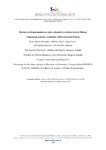Patrones de desplazamiento al centro educativo en adolescentes de Huesca

Use este enlace para citar
http://hdl.handle.net/2183/25534
Excepto si se señala otra cosa, la licencia del ítem se describe como Atribución-NoComercial-SinDerivadas 4.0 Internacional
Colecciones
Metadatos
Mostrar el registro completo del ítemTítulo
Patrones de desplazamiento al centro educativo en adolescentes de HuescaTítulo(s) alternativo(s)
Commuting Patterns to School in Adolescents From HuescaAutor(es)
Fecha
2020Cita bibliográfica
Montañés, L., Solana, A., Catalán, Ángel, González, L., & Serrano, J. (2020). Patrones de desplazamiento al centro educativo en adolescentes de Huesca. Sportis. Scientific Journal of School Sport, Physical Education and Psychomotricity, 6(2), 286-307. https://doi.org/10.17979/sportis.2020.6.2.5975
Resumen
[Resumen] El objetivo del estudio fue describir el tipo de desplazamiento utilizado por los adolescentes
de Huesca para ir y volver del centro educativo, así como analizar su asociación con el género
y el curso académico. Participaron 1.709 adolescentes (Medad=14.20; DT=1.56; 51.7%
chicas) de 1º de Educación Secundaria Obligatoria (ESO) a 1º de Bachillerato. Los
estudiantes cumplimentaron un cuestionario sobre el modo habitual de desplazamiento en la
ida y vuelta al instituto. Los resultados señalaron que un 76.4% de los adolescentes se
desplazaba activamente (i.e., andando o en bicicleta) tanto en la ida como en la vuelta. De los
adolescentes que se desplazaban activamente, un 78.5% en la ida y un 81.7% en la vuelta lo
hacía caminando. En relación con el género, se encontró una asociación positiva entre ir
andando al centro educativo y ser chica, así como entre ir en bicicleta y ser chico. En relación
con el curso académico, desplazarse andando al centro educativo se asoció positivamente con
4º de ESO y negativamente con 1º de Bachillerato. Asimismo, desplazarse en bicicleta se
asoció positivamente con 1º de Bachillerato y negativamente con 3º de ESO. Aunque la
mayoría de los adolescentes se desplaza activamente al instituto, parece necesario promover
programas escolares que incentiven el desplazamiento activo de los jóvenes dada las
características favorables de movilidad de la ciudad de Huesca. De igual modo, parece
necesaria la promoción de la bicicleta como modo de desplazamiento al instituto,
especialmente en las chicas y en los estudiantes de ESO. [Abstract] The aim of this study was to describe the usual mode of commuting to and from school in
adolescents of Huesca and its association with gender and academic year. A total of 1,709
adolescents (Mage=14.20; DT=1.56; 51.7% girls) from 1st-year of middle school [Spanish
acronym, ESO] to 1st-year high school) participated in this study. A questionnaire of the usual
mode of commuting to and from school was self-reported by students. Results showed that
76.4% of adolescents commuted actively (i.e., walking or cycling) to and from school. Of the
adolescents who commute actively to and from school, 78.5% to school and 81.7% from
school walked. Regarding gender, a positive association was found between walking to and
from school and being a girl, as well as between cycling and being a boy. Regarding the grade
level, walking to and from school was positively associated with adolescents in 4th of middle
school and negatively with 1st-year high school. On the other hand, travelling by bicycle both
routes was positively associated with 1st-year of high school and negatively with 3rd year of
middle school. Although the majority of adolescents from Huesca commuted actively to and
from school, it seems that active school transport interventions are necessary, given the
favorable characteristics of the city of Huesca. Similarly, it seems necessary to
promote cycling as a means of transport to and from school, especially among girls and
secondary education students.
Palabras clave
Desplazamiento activo
Bicicleta
Andar
Género
Curso académico
Active commuting
Cycling
Walking
Gender
Academic grade
Bicicleta
Andar
Género
Curso académico
Active commuting
Cycling
Walking
Gender
Academic grade
Versión del editor
Derechos
Atribución-NoComercial-SinDerivadas 4.0 Internacional
ISSN
2386-8333






